Left-Sided Nephrectomy
After insufflation with carbon dioxide to an intra-abdominal pressure of 5 mmHg and visualization of the nephrosplenic region, the 5-mm-diameter laparoscopic injection needle is inserted into the instrument portal 2. To decrease the splenic size and subsequently enlarge the working space (as far as necessary), the dorsal border of the spleen is injected at three to four places with 1 mg epinephrine diluted in 10 mL of sterile saline solution. The lateral border of the perirenal fascia is then infiltrated with 20 mL of 2% mepivacaine (Figure 20.2). After infiltration anesthesia, the perirenal peritoneum is incised in a horizontal plane using endoscissors (10 mm) or a monopolar reusable electrocautery hook starting from the caudal edge of the nephrosplenic ligament toward the craniolateral edge to a length of 10–15 cm (Figure 20.3).
Figure 20.2 (A) Laparoscopic view of the nephrosplenic region and the left kidney. (B) Infiltration anesthesia of the perirenal fascia.
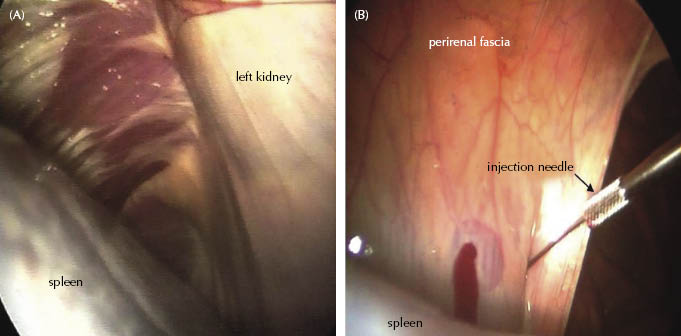
Figure 20.3 Dissection of the perirenal fascia in a horizontal plane using endoscissors from the caudal edge toward the cranial edge (A,B).
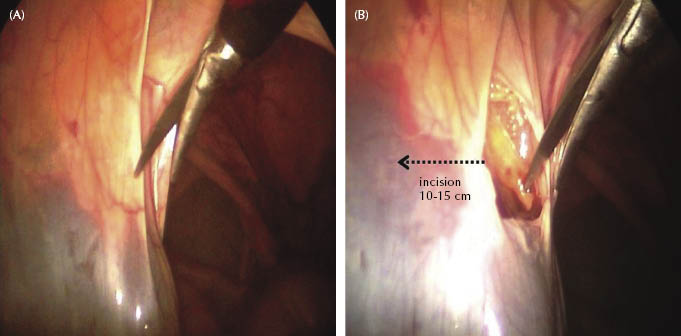
Right-Sided Nephrectomy
After visualization of the retroperitoneally located kidney dorsal to the base of the cecum, a subperitoneal infiltration anesthesia (20 mL of 2% mepivacaine) is performed. The perirenal fascia is horizontally divided about 10 cm dorsal of the duodenal mesenterial vessels to a length of 10–15 cm using endoscissors (Figure 20.4).
Figure 20.4 (A) Visualization of the right kidney dorsal to the base of the cecum. (B) Horizontal incision of the perirenal fascia using endoscissors.
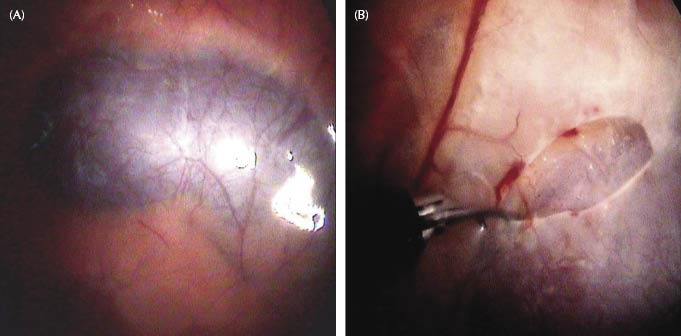
From this point on, all following surgical steps are performed in the same manner whether left-sided or right-sided. To assure a hand-assisted procedure in the further process, the third portal is created as a 10- to 15-cm-long ventrally directed mini-laparotomy, located about 5 cm caudal to the second portal at the ventral border of the tuber coxae in the center of the paralumbar fossa according to the size of the surgeon’s hand. The external abdominal oblique muscle is sharply incised, and a modified grid technique is used to expose the peritoneum, which is also sharply incised. The incision of the perirenal fascia is digitally enlarged—left-sided, right-handed and right-sided, left-handed—under visual control by the surgeon’s hand, which is inserted transabdominally through the mini-laparotomy (Figure 20.5). With the inserted hand, the particular kidney is circularly and bluntly dissected free from the perirenal fat and mobilized (Figure 20.6). Division of the perirenal fat has to be accomplished carefully, especially on the right side, to avoid damaging the cecal roof ventrally and the diaphragm cranially. Generally, the left-handed circumferential isolation of the kidney is more difficult on the right side because of its more cranial location and its proximity to the posterior vena cava, which is more sensitive to laceration than the aorta on the left side. Instead of using a hand-assisted procedure, the kidney can also be bluntly dissected free from the perirenal fat on its dorsal aspect using laparoscopic scissors and atraumatic grasping forceps introduced through the third portal.
Figure 20.5 (A) Laparoscopic portal and mini-laparotomy in the flank. (B) Inserted right hand for a left-sided hand-assisted procedure.
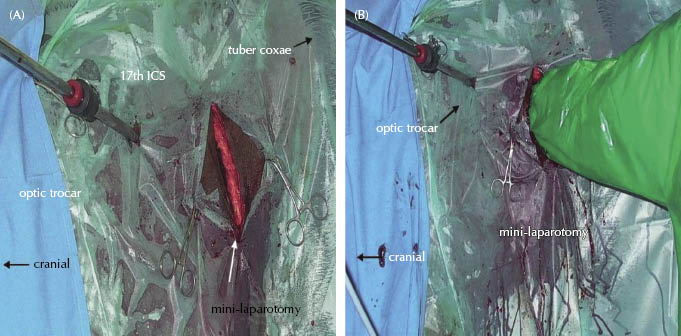
Figure 20.6 With the retroperitoneally inserted hand (H), the kidney (K) is bluntly dissected free from its perirenal attachments under visual control (A,B).
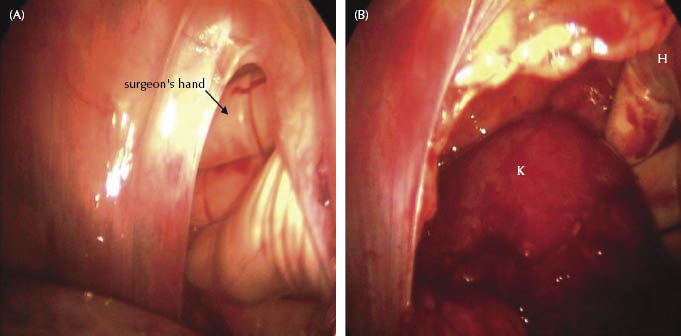
Due to mobilization, the kidney drops slightly to a more ventrolateral position, which improves the visualization of the anatomical structures. The laparoscope is then introduced in the retroperitoneal space so that the isolated vessels and the ureter running in the direction of the kidney hilus can be visualized and digitally divided under laparoscopic control (Figure 20.7). In its course toward the kidney hilus, the renal artery often splits up, different in each species, into multiple branches. Additionally, accessory branches can be found in individual cases. The individual vessels are manually and/or instrumentally separated and ligated with a 240-cm-long, braided lactomer suture (USP 1), effectively coagulated by application of the vessel-sealing system (LigaSure) or occluded with Endoclips.
Figure 20.7 Laparoscopic visualization of the hilus region, the isolated vessels (A), and the ureter (B).
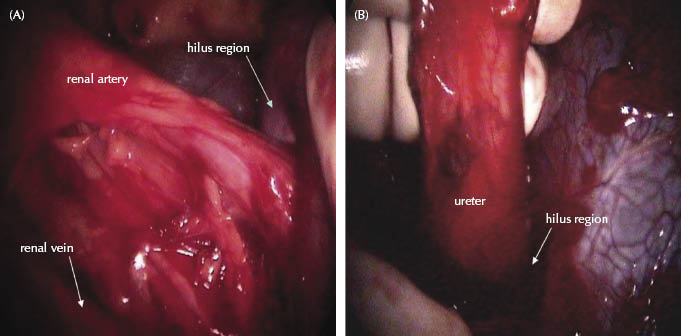
At first, the renal artery and its branches are sutured to avoid blood congestion of the kidney. Two ligatures are made close to the aorta, and then a further ligature is placed close to the hilus (Figure 20.8). The ligatures of the renal vein are accomplished in the same fashion. The ligatures of the individual vessels are performed manually and/or instrumentally assisted. Smaller luminous, accessory vessels are coagulated electrosurgically or clipped. The digitally free dissected ureter is also ligated two times. The vessels as well as the ureter are dissected in between the ligatures under laparoscopic observation especially regarding secure hemostasis. The completely mobilized kidney is fixed with a grasping forceps and the mini-laparotomy is then enlarged for removal according to the size of the kidney (Figure 20.9). In case of hydronephrosis or renal abscess, size reduction of the kidney is accomplished by suction before extraction. To keep the mini-laparotomy as small as possible, before removal, the resected kidney can also be placed in a sterile plastic disposable surgical drape or caught in an endoscopic retrieval bag for morcellation and to prevent portal site metastasis or infection.
Figure 20.8 Ligation of the isolated vessels is performed hand-assisted under laparoscopic observation (A,B).
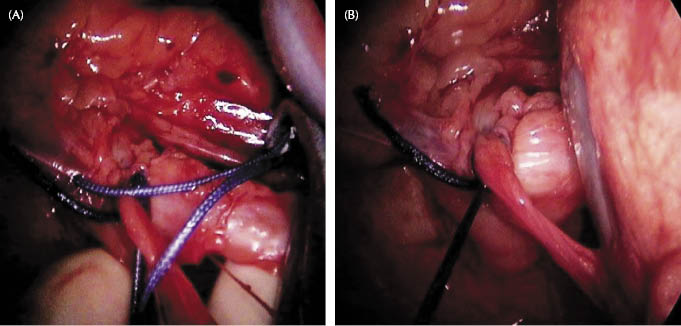
Stay updated, free articles. Join our Telegram channel

Full access? Get Clinical Tree


